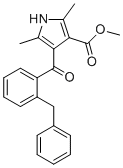
CDN1163
CAS No. 892711-75-0
CDN1163( CDN 1163 | CDN-1163 )
Catalog No. M16438 CAS No. 892711-75-0
CDN1163 (CDN-1163) is a small molecule, allosteric activator of SERCA2.
Purity : >98% (HPLC)
 COA
COA
 Datasheet
Datasheet
 HNMR
HNMR
 HPLC
HPLC
 MSDS
MSDS
 Handing Instructions
Handing Instructions
| Size | Price / USD | Stock | Quantity |
| 2MG | 34 | In Stock |


|
| 5MG | 55 | In Stock |


|
| 10MG | 80 | In Stock |


|
| 25MG | 149 | In Stock |


|
| 50MG | 266 | In Stock |


|
| 100MG | 470 | In Stock |


|
| 200MG | Get Quote | In Stock |


|
| 500MG | Get Quote | In Stock |


|
| 1G | Get Quote | In Stock |


|
Biological Information
-
Product NameCDN1163
-
NoteResearch use only, not for human use.
-
Brief DescriptionCDN1163 (CDN-1163) is a small molecule, allosteric activator of SERCA2.
-
DescriptionCDN1163 (CDN-1163) is a small molecule, allosteric activator of SERCA2, dose-dependently increases the Vmax of SERCA2 Ca2+-ATPase activity in ER microsomes; increases Ca2+-ATPase activity and significantly enhances Ca2+ uptake into the ER, attenuates H2O2-stimulated cell death in HEK cells; improves glucose homeostasis and metabolic parameters, increases glucose tolerance in ob/ob mice; CDN1163 reduces lipid accumulation and decreases lipogenesis in obese mice livers.
-
In VitroCDN1163 (10μM; 24 hours; rat cardiac myocyte cells) treatment reduces high glucose-induced resistin and nuclear NFATc expression and increases the phosphorylation of AMPKα in a time-dependent manner. Western Blot Analysis Cell Line:Rat cardiac myocyte cells (H9c2)Concentration:10?μM Incubation Time:24 hours Result:High glucose-induced resistin and nuclear NFATc expression are significantly reduced. The phosphorylation of AMPKα is increased in a time-dependent manner.
-
In VivoCDN1163 (50 mg/kg; intraperitoneal injection; for 5 days; male ob/ob mice and lean ob/+ mice) increases SERCA2 Ca2+-ATPase activity, decreases endoplasmic reticulum (ER) stress-induced cell death in vitro and improves liver Ca2+ transport activity. CDN1163 reduces blood glucose levels and improves metabolic parameters and gluconeogenic gene expression, reverses hepatic steatosis, inhibits ER stress and ER stress-induced apoptosis, and improves mitochondrial efficiency in ob/ob mice in vivo. Animal Model:Male 8-10-week old ob/ob mice and lean ob/+ mice Dosage:50 mg/kg Administration:Intraperitoneal injection; for 5 days Result:Markedly lowered fasting blood glucose, improved glucose tolerance, and ameliorated hepatosteatosis but did not alter glucose levels or body weight. Increased expression of uncoupling protein 1 (UCP1) and UCP3 in brown adipose tissue and reduced the hepatic expression of genes involved in gluconeogenesis and lipogenesis, attenuated ER stress response and ER stress-induced apoptosis, and improved mitochondrial biogenesis, possibly through SERCA2-mediated activation of AMP-activated protein kinase pathway.
-
SynonymsCDN 1163 | CDN-1163
-
PathwayGPCR/G Protein
-
TargetCalcium Channel
-
RecptorCalcium Channel
-
Research Area——
-
Indication——
Chemical Information
-
CAS Number892711-75-0
-
Formula Weight320.392
-
Molecular FormulaC20H20N2O2
-
Purity>98% (HPLC)
-
SolubilityDMSO : 50 mg/mL 156.06 mM; H2O : < 0.1 mg/mL
-
SMILESO=C(NC1=C2N=C(C)C=CC2=CC=C1)C3=CC=C(OC(C)C)C=C3
-
Chemical Name4-(1-Methylethoxy)-N-(2-methyl-8-quinolinyl)benzamide
Shipping & Storage Information
-
Storage(-20℃)
-
ShippingWith Ice Pack
-
Stability≥ 2 years
Reference
1. Krajnak K, et al. Bioorg Med Chem Lett. 2018 May 15;28(9):1591-1594.
2. Kang S, et al. J Biol Chem. 2016 Mar 4;291(10):5185-98.
3. Dahl R. Bioorg Med Chem. 2017 Jan 1;25(1):53-57.
4. Cornea RL, et al. J Biomol Screen. 2013 Jan;18(1):97-107.
molnova catalog



related products
-
Procyanidin A1
Procyanidin A1 has antiallergic effects, it inhibits degranulation downstream of protein kinase C activation or Ca2+; influx from an internal store in RBL-2H3 cells.
-
Upacicalcet
Upacicalcet (AJT-240) is an intraventricular calcium mimetic, a SHPT available for human hemodialysis, that inhibits excessive parathyroid hormone (PTH) secretion by directly acting on parathyroid cell membrane calcium-sensitive receptors, thereby lowering blood levels of PTH.
-
Jasmonic acid
Jasmonic acid (JA) is a phytohormone and plant growth regulator involved in plant defense and growth and development.



 Cart
Cart
 sales@molnova.com
sales@molnova.com


